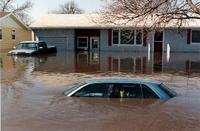Sandy May Have Damaged or Destroyed Up To 200,000 Cars
Washington DC November 8, 2012; The NADA newsletter reported that according to the Wall Street Journal hurricane Sandy destroyed tens of thousands of cars in the Northeastern U.S.
The storm's devastation could send ripples through the region's new and used auto markets for weeks. The National Automobile Dealers Association on Tuesday estimated that as many as 200,000 vehicles may have been damaged in the storm — a figure extrapolated from the devastation wrought by Hurricane Katrina.
For perspective, auto makers sold just over 1 million cars and trucks in October. Sandy, NADA analysts say, doesn't appear to have destroyed as many vehicles than the areas hit by Katrina.
Consumer Affairs.com in a story by Truman Lewis titiled Flooded Cars Likely to Find Their Way to Market Car buyers beware! That cream puff may have been submerged published November 7, 2012 offers lots of god advice to car buyers.
Superstorm Sandy is gone but among the wreckage it left behind are thousands of cars and trucks damaged by flood waters. Many of these water-damaged vehicles may soon be finding their way to the marketplace, as scam artists buy cars totaled by insurers, thoroughly clean them and attempt to resell them.
While there is no sure way to know if a vehicle has been damaged by flooding, the National Automobile Dealers Association offers 10 inspection tips that may be used to detect water damage. A prospective buyer can spot a flooded vehicle by following these simple steps:
1. Check the vehicleís title history by VIN through commercially available vehicle history reports from Experianís Auto Check or through the National Insurance Crime Bureauís VinCheck. The report may state whether a vehicle has sustained flood damage.
2. Examine the interior and the engine compartment for evidence of water and grit from suspected submersion.
3. Check for recently shampooed carpet.
4. Look under the floorboard carpet for water residue or stain marks from evaporated water not related to air-conditioning pan leaks.
5. Inspect for rusting on the inside of the car and under interior carpeting and visually inspect all interior upholstery and door panels for any evidence of fading.
6. Check under the dashboard for dried mud and residue, and note any evidence of mold or a musty odor in the upholstery, carpet or trunk.
7. Check for rust on screws in the console or other areas where the water would normally not reach unless submerged.
8. Look for mud or grit in alternator crevices, behind wiring harnesses and around the small recesses of starter motors, power steering pumps and relays.
9. Complete a detailed inspection of the electrical wiring system looking for rusted components, water residue or suspicious corrosion.
10. Inspect the undercarriage of other components for evidence of rust and flaking metal that would not normally be associated with late model vehicles.
While these inspection suggestions will not detect flood damage in every case, they do provide some information to protect the consumer from purchasing a vehicle damaged by water or flood.



